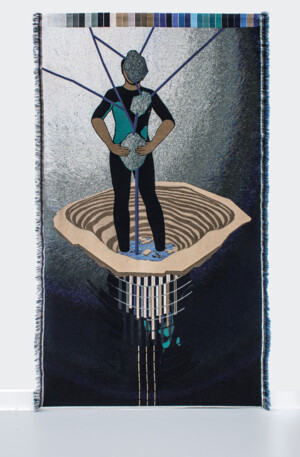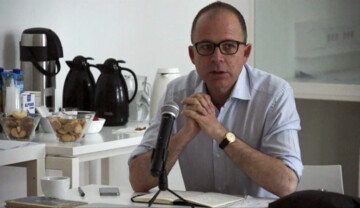Here, naturally, I dream first and foremost of that extraordinary network of radiophonic and televisual communications that, perhaps anticipating a direct tuning-together of our brains with the help of the as yet mysterious forces of telepathy, is, already today, connecting all of us to a kind of ‘etherealised’ common consciousness.
— Pierre Teilhard de Chardin, 1947

Figure: Otobong Nkanga: Infinite Yield, 2015. Collection M HKA, Antwerp / Collection Flemish Community © M HKA.
This term forecasts a future state of being when our planet is enveloped in a communicative web of common thought, a new layer of “thinking substance” that may eventually transform it into a “thinking Earth”. (Figure)
In analogy with the geosphere and the atmosphere, Austrian geologist Eduard Suess (1821–1914) coined the term “biosphere” (“sphere of life”) in 1885, to stress the formative role of live matter in the Earth’s development. The “noosphere” (“sphere of thought”) is a further analogy focusing on the evolution of intelligent life as a directed and non-sporadic process of “cephalisation” (the gradual centralisation, in living beings, of an increasingly complex nervous system, ultimately leading to the self-reflective mind and scientific method). The new term was most probably coined in 1921 by French palaeontologist, theologian and Jesuit priest Pierre Teilhard de Chardin (1881–1955). From 1926 onwards it was also used, but in a different way, by Russian mineralogist and geochemist Vladimir Vernadsky (1863–1945).
The two men, who met in Paris in the early 1920s, held very different convictions. Teilhard, innovating within his Christian belief system but staying true to it, imagined the ever-increasing complexity of the noosphere eventually replaced by a super-mind and resolved in the “Omega-Point”, a metaphor for the divine force that, for him, predated the creation of the universe. Vernadsky, who maintained that Bolshevism was ”founded on sound principles”, and was awarded the Stalin Prize in 1943 for his contributions to the Soviet nuclear arms programme, rejected any mystic or spiritual interpretations of the noosphere. On the other hand he thought it capable of spreading, together with humans, throughout the Cosmos.
If we want, we may say that Teilhard privileged the spherical form of the noosphere, describing it as a layer superimposed on the biosphere, which in turn is shaped by Earth, and regarded it as the final stage in the separation of energy (“the within of things”) from matter (“the without of things”), which both appeared at the atomic level of creation. (This conflation of creationism and evolutionism was made possible by Henri Bergson’s influential book Creative Evolution, from 1908.) Correspondingly, we may say that Vernadsky, who insisted on a strict distinction between live and inert matter, privileged the thought-content of the noosphere, never endowing it with a spatial or temporal existence of its own but treating rather as a specific non-material aspect of the biosphere. We should note, however, that both Teilhard and Vernadsky committed the cardinal sin of futures studies: making predictions about the future based on speculative observations of the present and past.
For all its ideological and methodological flaws, the noosphere remains an intriguing concept, ripe for rediscovery and reuse. It is tempting to read Teilhard’s effusive notes about information technology as proof that the Internet, the medium that conditions our life today, somehow already is the noosphere. But does the Internet really make sense as an image of the sphere of thought? While it is sometimes said that the amount of writing added to the Internet every year is now greater than the combined libraries of the world, much of it is just typing, as Vilém Flusser would have said. And besides, quite a lot of this typing is about Justin Bieber or Kim Kardashian or Donald Trump…
The issue of “common thought” also remains intriguing, and perhaps more relevant now than ever, precisely because of this rapidly expanding infrastructure for digital communication. How do we, as the species that drives planetary change in the Anthropocene era, actually share thoughts which each other? How do we “think together”? The traditional answer, which has only been reinforced by the extensive use of writing on the Internet, is that telepathy is indeed possible – as long as it happens through the medium of language.
In his almost ecstatic vision for the noosphere, Teilhard suggests that we might be able to pool thoughts, and make them truly “common”, without recourse to a shared language. This idea is probably as old as the faculty of speech itself, and the fragmented complexity it gave rise to. A recent hypothesis about land use in pre-conquest Australia is that the entire continent functioned as one commonly owned and sustainably managed estate for some 70,000 years, despite the fact that its various peoples spoke different and often completely unrelated languages. Did the ancient Australians have access to special telepathic channels of exchange? Should their “song lines” and “dream time” be interpreted as “noospheric” avant la lettre?
This little excursion into indigenous culture should not be understood as an endorsement of the new-age aspects (also avant la lettre) of how both Teilhard and Vernadsky used their term. Quite the opposite: that has left it slightly tainted. The interesting challenge now is to reclaim the noosphere for thinking about the common, for enabling humans to unite around common thought even if they appear to lack the necessary communicative tools, or the operative knowledge of the differences that separate them. How can the “uncontacted tribes” of the upper Amazon possibly think and work together with “radical” Westerners? Such examples abound. Their political connotations are obvious.
Perhaps – and this is a long shot, but one worth taking – institutions exhibiting contemporary art achieve noospheric results without quite realising it. In the final analysis, they appeal to our need for thinking rather than our love of knowledge. Thinking tends to address and be stimulated by visual experience. This is one reason why the “how” usually trumps the “what” when the output of art museums and galleries is subjected to serious evaluation. Following this logic, which appears to be reconcilable with Teilhard’s simultaneous quest for complexity and its absolute opposite, art and art exhibitions should challenge the unfair dominance that descriptive and prescriptive language is granted over our lives.
Moreover, what French artist Robert Filliou, in his “research on pre-biology”, called the “built-in” and the “built-upon” appears to correspond to Teilhard’s within and without of things. Advanced technology can only enhance the reality of thought, not fundamentally alter it. Thought does not need artificial intelligence. But it does need a workable notion of the common, unless it wants to remain a rarefied elite pastime with a somewhat ironical retrospective bent. No, dusting off Teilhard and Vernadsky is not the point here. And no, the Internet is not the noosphere they dreamt of 70 or 80 years ago. The noosphere remains an unrealised project. There is work to do in the sphere of thought.



